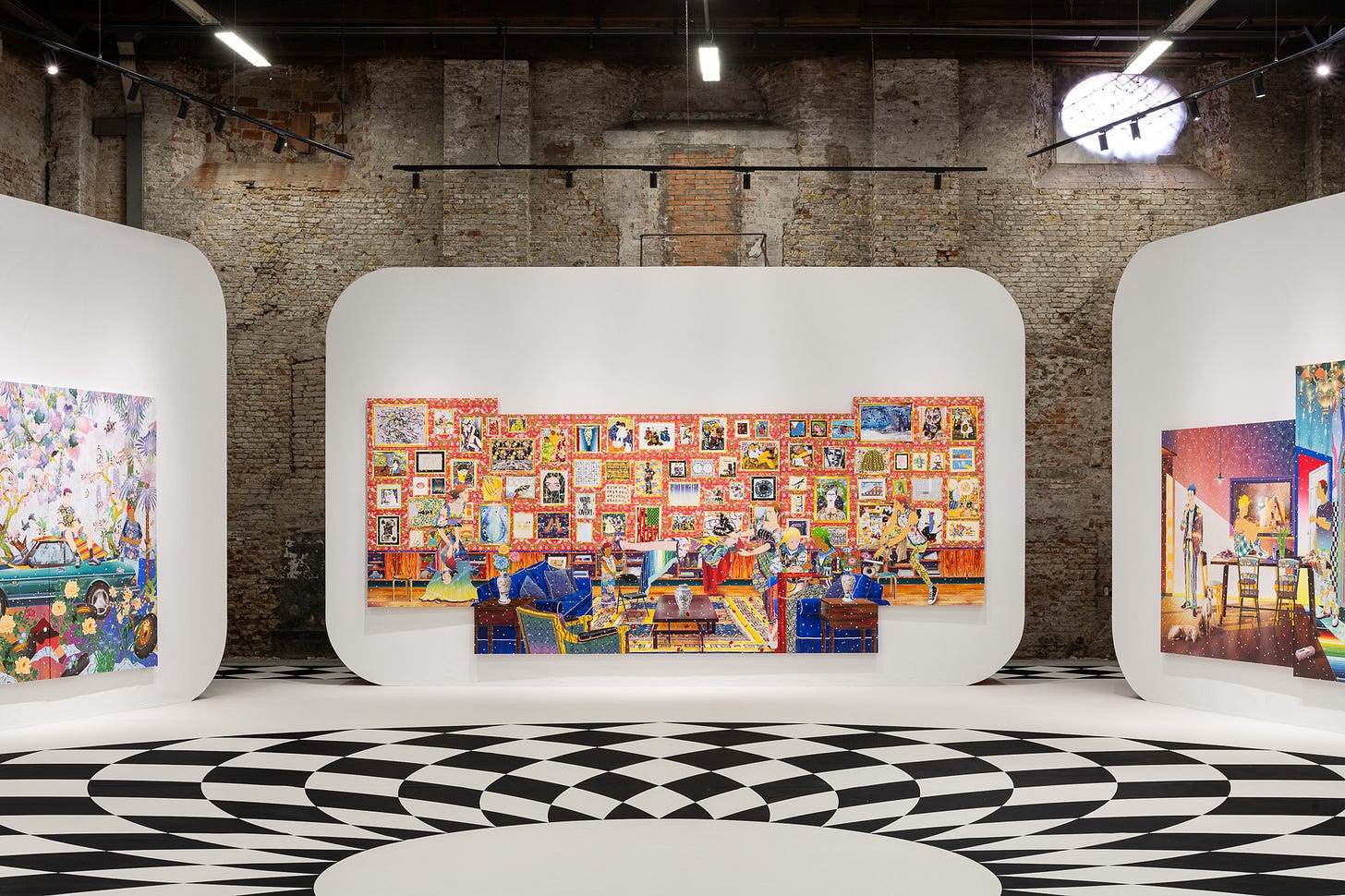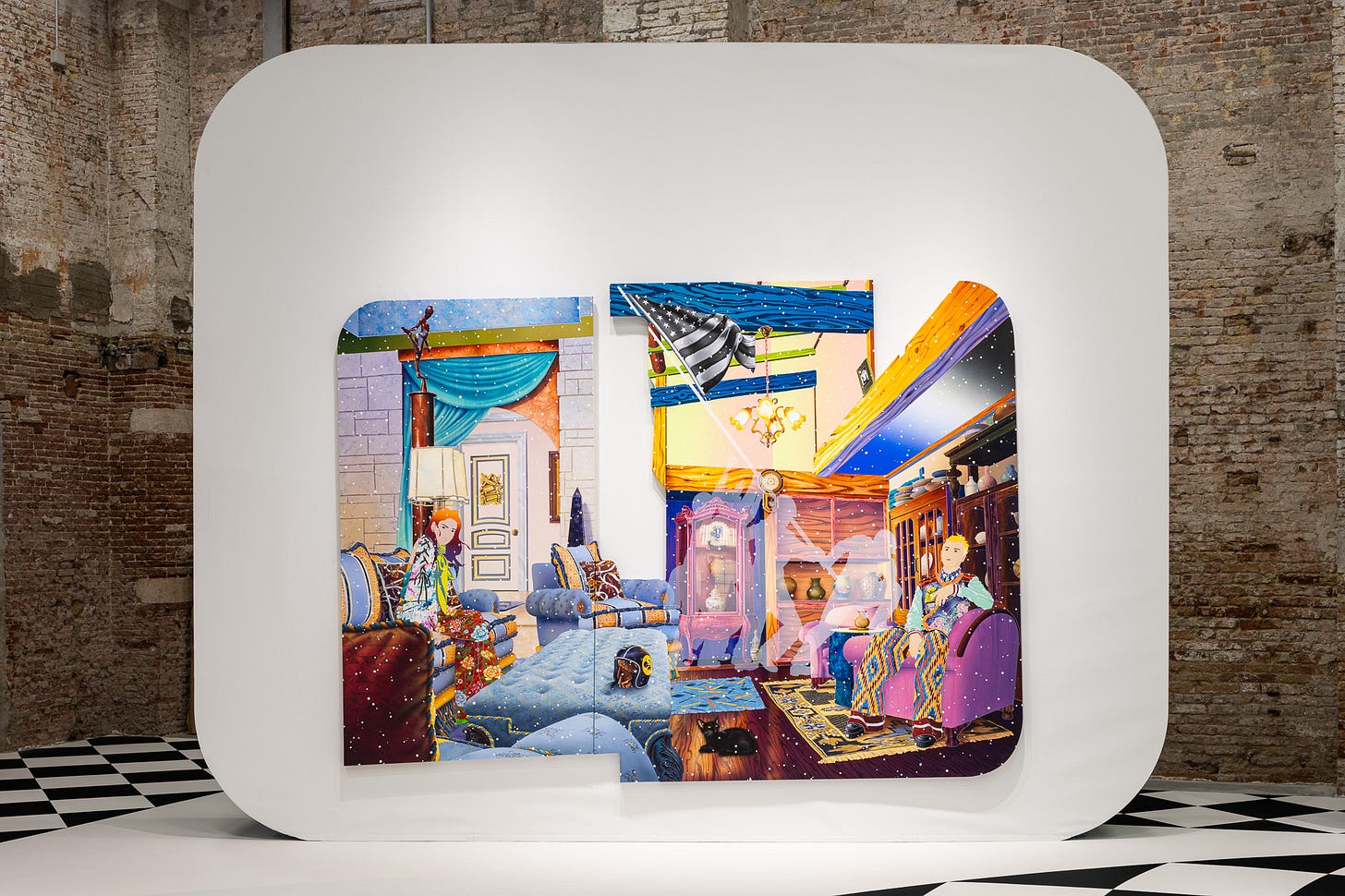Long Live The Ornament! Tomokazu Matsuyama in Venice
Tomokazu's (Gen X, Japanese) overwhelmingly bright and detailed paintings are teleportation devices into what this world is on the other side of reality.
I walked into a hall that was once part of a huge industrial complex of the Venetian fleet. But there were no historical ship parts or other material residue. Instead, I entered a dizzying portal: A concentric illusionary floor surrounded by eight enormous, highly saturated hyperornamental paintings on seven even larger rectangular walls with rounded edges. I felt like I’ll either fall into hypnosis or lose my balance. Or both. This portal did not catapult me into the past but rather into a parallel world.

Curatorially speaking an absolute slay. The curation beautifully compliments and enhances the sensation of overwhelm. I was slightly alienated by the title, though: Mythologiques. What’s the connection to mythology? And, most important: why is it French?
When too much is just right
Tomokazu samples a variety of textures for his works. The people he paints wear diverse types of fabrics and prints from batik to florals, everything all at once. The environents his figures find themselves in are similarly overloaded with patterns and ornaments from various epoques and cultures. By various epoques and cultures I mean Hello Kitty meets Persian tapestries. While some patterns are meticulously sculpted to fit the bodies and objects they should wrap around, other textures appear patched together on the surface.
This approach is part of superflat art, a contemporary art style orginally from Japan. Takashi Murakami (Baby Boomer, Japanese) who happened to design Kanye West’s iconic Graduation album and J Balvin’s album Colores is most prominent within this style. Takashi’s former assistant Soraya Sharghi (Millenial, Iranian) continues to work in superflat style as well.
While Takashi’s paintings are dominated by smiling rainbow flowers and teeth-grinding cartoonish creatures and Soraya paints androgynous heroines from mythologies with pop-cultural references here and there, Tomokazu’s works deal with who we are.
What’s us? That’s what I think of myself when I’m painting and creating art in New York City. - Tomokazu Matsuyama, artist interview with Avant Arte
Tomokazu lives in Brooklyn, he grew up living in Japan and the US. So who is the we in question? Is it the West? The East? Both? None? Humanity as a whole? If there’s a we there’s always a they, too. As I came to understand Tomokazu’s we, it’s not a geographical one but one marked by time. Who are we today?

The Myth of Modernity
Every painting is veiled with white shiny dots. Not as regular as Yayoi Kusama’s (Silent Generation, Japanese) polka dots, but rather like a snow storm. Does it mean anything? I don’t know. Most paintings aren’t simply rectangular canvases, but several canvases arranged in assymetrical compositions, pushed together, edges and contours cut to fit the painted content. Catharsis Metanoia (2024) for example isn’t simply made up of differently sized canvases, but the whole piece follows the outline of the painted blue sofa and wooden beams. This combination of pop cultural references and unconventional shapes reminds me of American painter James Rosenquist (1933-2017), take for instance his F-111 (1964–65) or Space dust (1989). There’s no one culture but many overlapping ones we’re part of.
Tomokazu samples both important artworks from art history and popular images from the internet which results in pictures that feel both timeless and contemporary. You, One Me Erase (2023) is basically a huge red commemorative wall for other important artists that Tomokazu overlaid with his signature patterns. There’s a Frieda Kahlo self portait, Diane Arbus’s Identical Twins, Roselle, New Jersey (1967) photograph, Niki de Saint Phalle’s Nana figures, an On Kawara painting, Keith Haring’s cartoonish figures, Barbara Kruger’s Your Body is a Battleground… Shall I go on? I think you got the gist. This wall along with the mid century modern furniture is the backdrop to other art historical figures. Most prominently, a freestyled version of Caravaggio’s Judith beheading Holofernes (c. 1598–1599).
While this advanced memory match game surely is fun and challenging… what’s the point? I don’t mean to be polemic, I’m genuinely wondering. Is it a critique of how art history turns into nothing but decor for our delusional main character plots? Is it an hommage to art that inspires Tomokazu? But what’s in for me then as a viewer? I wouldn’t have thought that I’d be quoting Kamala Harris on here anytime soon, but it looks like Tomokazu wants to remind us that we didn’t just fall out of a coconut tree but exist in the context of all in which we live and what came before us.
This work among others in this exhibition is slightly shaped like an altar piece with a prominent central part and two wings. If Tomokazu builds altars, what religion do they serve?
Reclaiming the Ornament
Another artist who pays close attention to ornaments is Kehinde Wiley (Gen X, American) who nestles Black protagonists into hyperornamental surroundings inspired by corner stones of Western Art History. Tomokazu’s By And By Daylight (2023) with young people by a car reminded me a lot of Kehinde.
The intense use of ornaments fits into an age-old debate on minimalism and decor as the spectrum that determines how “civilized” a people is. A highly questionable position was held by Austrian architect Adolf Loos (1870-1933). In his 1913 essay “Ornament and Crime”, Adolf argued that "[t]he evolution of culture marches with the elimination of ornament from useful objects," suggesting that Modern, ‘advanced’, ‘cultured’ societies are minimalist while ‘barbarian’ and ‘savage’ people use ornaments and decor. That’s why the absence of ornaments came to be associated with ‘cleanliness’ and cultural superiority. This is also why rich people stick to “quiet luxury” while middle and working class communities have very diverse and varied pop cultures.
Modernism claimed that in order to be taken seriously, you have to erase what marks your heritage. Only when you subject yourself to uniformity, you’re positioned to say something meaningful. I’m happy to see how artists don’t bend to this pressure.
This overwhelming use of patterns and textures is characteristic for 2020s visual overstimulation. Coming back to Catharsis Metanoia, I realize that there’s a physical and imaginary layer: While the woman on the left challengingly looks out to the viewer, the man on the right sitting on a pink sofa seems to be contemplating something. Maybe the ghostly silhouette of the 1945 war photograph which later turned out to be staged is what’s on his mind. I notice the flag’s pole is interrupted by the rounded canvas corner. The ghosts of the past are what makes our present. And yet we can decide whoever we want to be in this world of non-conformity.
Get entranced by pop culture with Tomokazu Matsuyama: Mythologiques, through November 2024 at Magazzino No. 41 Arsenale, Venice.
Magazzino No. 41
Marina Militare, Arsenale
Fondamenta Case Nuove, 2738c
Venice
Website
Instagram: @tomokazumatsuyama @ciacef
Did these pics make you dizzy as well? I’d love to hear your thoughts in the comments. If you liked the review, please leave a like and don’t forget to share this one with a friend while you’re at it!
See you soon!!!
Jennifer
The Gen Z Art Critic







I was honestly pretty underwhelmed by this work. The space and setting >> the art. Next door, on the other hand...